Introduction
Pricing strategies have the power to make or destroy a product in the cutthroat world of Software as a Service (SaaS). Businesses have to balance providing value to their clients with making a steady profit. Businesses frequently discuss usage-based pricing and flat-rate pricing as two of the most common pricing models.. Each pricing model offers unique benefits and limitations. Its effectiveness depends on the product, customers, and business goals. This article explores both pricing strategies. It weighs their pros and cons to guide businesses. The goal is to support informed decisions based on operations and customer behavior.
Understanding Usage-Based Pricing
Usage-based pricing, or the pay-as-you-go model, charges clients based on their actual usage. Platforms like AWS Lambda and Azure Functions use this model. They bill users according to the exact resources they consume. One major advantage is the clear link between cost and usage. Customers appreciate this transparency. It helps them feel more in control of their spending. This transparent cost-to-value ratio gives users more control and increases their trust in the service.
Additionally, usage-based pricing reduces the entry barrier for new clients who might be hesitant to pay a hefty upfront cost. Because customers are less likely to switch when they are only paying for what they use, it also encourages improved customer retention. Since higher utilization inevitably results in higher revenue, this strategy relieves SaaS providers of the obligation to upsell. As companies increase their infrastructure and services in tandem with use, it also fits in nicely with lean budgeting from an operational standpoint.
Nevertheless, the model has a number of drawbacks. It gets harder to anticipate revenue, particularly in the early phases of expansion. Unexpectedly large costs from use spikes may discourage customers from using a product to its full potential or cause discontent. Budgeting can also be difficult for customers, particularly if their usage fluctuates from month to month. This price approach necessitates precise, up-to-date tracking and billing systems internally, which can increase operational overhead and technical complexity. If companies don’t receive advance payments, they may experience irregular cash flow, especially during capital-intensive periods.
Understanding Flat-Rate Pricing
On the other hand, regardless of the actual amount of service utilization, flat-rate pricing provides a single, fixed fee for a range of features or usage levels. This paradigm is commended for being straightforward, easy to comprehend, explain, and implement. Customers can budget appropriately because they know exactly what they’re paying for, which makes this strategy especially appealing for small enterprises or customers with consistent, predictable needs.
Additionally, this price strategy promotes full service utilization. Customers are more inclined to investigate every function because they have already paid in advance, which frequently results in a deeper adoption of the product. Flat-rate pricing guarantees upfront revenue for SaaS companies, supporting planning and operational stability. Additionally, it’s frequently simpler to sell, particularly when the offering’s perceived worth surpasses the fixed charge.
However, there are drawbacks to flat-rate pricing.Flat-rate pricing follows a one-size-fits-all approach. It doesn’t consider the diverse needs and usage patterns of a growing customer base. Heavy users may get more value than they pay for. This can put a strain on company resources. On the other hand, light users might feel they are overpaying. This can lead to dissatisfaction or churn.Over time, this misalignment may have an effect on profitability. Rigid pricing tiers can also cause confusion for clients who are unsure of which plan best fits their needs, which can increase decision friction and perhaps result in churn.
Comparing the Two Models
The choice between usage-based and flat-rate pricing depends on several factors. These include product complexity, client expectations, and business maturity. Usage-based pricing works well for API-driven platforms and data processing services. It suits cases where usage varies and is tied to client success. Flat-rate pricing fits standardized services aimed at small teams or businesses. It appeals to those who want predictable, stable costs.
The distribution of risk is one of the main differences. Whereas flat-rate pricing passes that risk to the provider, usage-based pricing places additional financial uncertainty on the customer. Usage-based models can scale better for businesses aiming for fast user growth. Flat-rate pricing may suit companies that prefer steady, upfront revenue. Many businesses now adopt a hybrid approach. This combines usage-based charges with a fixed base fee. It offers a balance between flexibility and predictability. This model is becoming increasingly popular.
Conclusion
Selecting the best pricing model is a continuous strategic process rather than a one-time choice. Pricing strategy should change along with products and markets. Although usage-based pricing promotes scalability and offers dynamic value alignment, it comes at the expense of revenue predictability and difficulties with client budgeting. Although flat-rate pricing is straightforward and stable financially, it could not be flexible or equitable for a range of consumption patterns.
In the end, the ideal pricing strategy is one that accurately represents the worth of your goods, meets the needs of your clients, and advances your corporate goals. In order to modify their pricing in ways that promote growth and customer happiness, SaaS leaders must constantly examine usage trends, market trends, and consumer feedback.

